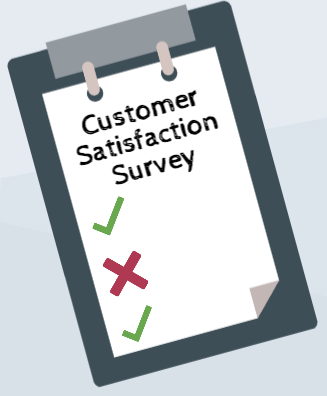Customer satisfaction surveys are the best way for businesses large and small to find out how customers really feel about products, services, and the shopping experience. But, unfortunately, not all companies use customer satisfaction surveys correctly.
Instead of using customer satisfaction survey data to identify areas of improvement for the entire organization, some companies use this same data to measure the performance of customer service representatives. Any responses, positive or negative, are then tied directly to compensation and factor heavily into performance reviews.
While this may seem like an easy way to check in on employee performance, the reality is that when used this way, customer satisfaction surveys become less effective and less accurate. These surveys are meant to measure customer satisfaction, not employee performance (there are different surveys for that). By maintaining focus on the customer experience, companies are better able to adjust practices and offerings to positively affect the bottom line.
Keep your customers and employees both satisfied by using feedback surveys to measure the reality of your business and gain insights that can result in beneficial changes.
Develop a Culture That Promotes Honesty to Get Good Customer Satisfaction Survey Results
 If your staff fears your customer satisfaction surveys, or if you attach bonuses or incentives to the results, then many employees will try to manipulate the surveys.
If your staff fears your customer satisfaction surveys, or if you attach bonuses or incentives to the results, then many employees will try to manipulate the surveys.
Employees at such an organization might feel the pressure to offer extra service, extra discounts, or even blatantly to pressure the customer for these top marks.
When employees do this, it is generally because they fear for their job or want the compensation that’s tied to the satisfaction scores.
Either way, they got a clear signal from upper management that the score, not their actual level of service, was all that mattered.
Gathering data in these customer satisfaction surveys should be a mechanism for the customer to have an honest conversation about their experience. The feedback that you get should be an opportunity for continuous improvement.
If you really want nothing but perfect scores, don’t distribute your surveys. Just take them yourself!
The data collected would be just as valuable in this case. Data gathered from an extremely biased process is useless.
Empower Employees to Give Good Customer Service Without Fear
There are times when a low customer satisfaction score can’t be avoided.
Customers may leave low feedback scores because employees followed a company policy they didn’t agree with, or the customer may be making unreasonable requests that cannot be accommodated.
There are even scenarios where a customer leaves a bad score by accident. Have you ever read a glowing 1-star review on Amazon? I know I have.
If your customer satisfaction surveys take these scenarios into account, your employees should be able to use their results to give better service to customers.
Empower your employees to reach out to customers that leave feedback, and see if their complaint can be addressed. They should also have the opportunity to thank customers who offer positive feedback.
Even if you cannot do what they request or resolve their complaint, sometimes an honest explanation goes a long way with a dissatisfied customer.
No matter the scenario, your employees should not fear reprisal for each incident that arises that may be totally out of their control.
Using the Right Questions for Customer Satisfaction Surveys
If you’re truly interested in getting useful data from your customer satisfaction surveys, and you’ve established a culture that promotes honesty in gathering customer feedback, make sure to construct your surveys properly.
Along with the common, “Please rate your experience on a scale of 1-5” type questions, make sure you include open text questions as well.
Rating questions and NPS (Net Promoter Score) can give you solid quantitative data, but allowing customers to communicate their experience in their own words will give you invaluable qualitative data to go with it.
Pressing the Reset Button On Customer Satisfaction Survey Collection
If your company is currently demanding only perfect survey scores, I would suggest that you immediately stop your customer satisfaction surveys for a period of time.
This will signal to employees a fundamental shift in how survey results are being handled. The skewed data that you would have collected during the downtime would be useless anyway.
As an organization, find out what you want to gain from your customer satisfaction surveys in the future. (A good place to start would be our best practices video series on Great Survey Design.)
Meet with all stakeholders in the company. Explain the shift in how you want to deal with customer satisfaction surveys. Assure your employees that you want honest feedback from customers to improve and that it will not be used to punish or promote.
Make sure you keep your word after the survey relaunches.
You may also want to consider leaving your front line employees out of the decision making process regarding who gets the survey. Instead select from your customer base randomly.
However, do share the feedback with the employee and assure them that perfection is great, but knowledge and understanding of your customers needs is even better!
Relaunch your survey and learn to act on data collected and look at it as an opportunity for continuous improvement.
How We Do Customer Satisfaction Surveys
At Alchemer we have weekly company meetings where we analyze trends in our NPS scores and comments. We examine the data and work hard at keeping our customers happy.
We reach back out to those that take our NPS surveys and try to resolve their complaint or provide honest explanations. Either way our agents are empowered to provide stellar customer service!